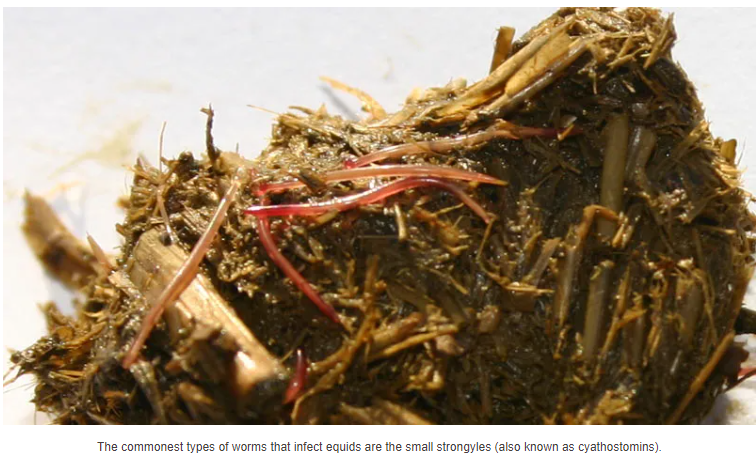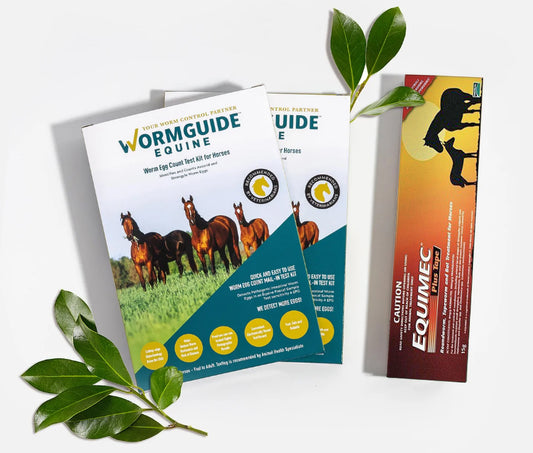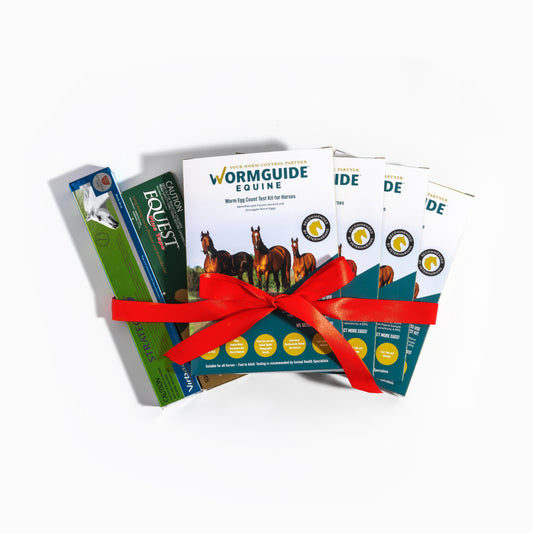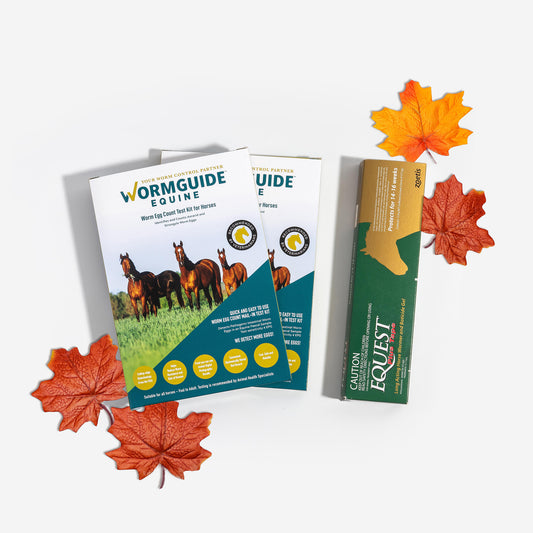** Attention Horse Owners **
BREAKING EQUINE NEWS
First evidence of horse worms in Australia that can no longer be killed by all the
worming products on the market.
This is a BIG CONCERN and very serious. Until now the macrocyclic class (ivermectin, moxidectin abamectin) was our last line of hope and defence against the most pathogenic intestinal horse worms, the small strongyles (cyathostomins).
The only thing we can do is delay further resistance development. We can`t prevent it but we can slow it down by testing more and treating less.
Do not wait. Worm the right way to keep your horses safe.
If you don`t select worming treatments carefully, you can get it wrong. That either accelerates the resistance process or leaves your horse unprotected, or both.
Thanks to the awesome team from www.horsetalk.co.nz we have permission to share their important article with you. Please keep reading to find out what's really going on!
First evidence of cyathostomin resistance in Australia to top-shelf dewormer
The first evidence that small strongyles in Australia are becoming resistant to one of the most powerful anti-parasitic drugs on the market has been reported by researchers.
Ghazanfar Abbas and his fellow researchers said their study, reported in the journal Parasites and Vectors, provides the first evidence of moxidectin and multidrug-resistant cyathostomins in Australia.
Their findings, they said, point to the need for continuous surveillance of the efficacy of currently effective deworming drugs. They said there is also a need for large-scale investigations of these products to assess egg reappearance periods, which can indicate the rise of drug resistance among parasites.
Small strongyles, also known as cyathostomins, are the most important and common parasitic nematodes of horses, with more than 50 species known worldwide.
Small strongyles have a direct life-cycle, with horses becoming infected by ingesting third-stage infective larvae while grazing. The infective larvae develop into adult worms in the large intestine.

Most infections are subclinical, while clinical forms of larval cyathostominosis – the emergence of fourth-stage larvae from the intestinal wall in large numbers – include weight loss, colic, fever, diarrhea, fluid build-up under the skin, and very low blood protein levels. Such cases can kill up to half of affected horses aged six or younger.
Control of small strongyles in horses has traditionally relied on interval-based deworming using three classes of anthelmintics – benzimidazoles, tetrahydropyrimidines and macrocyclic lactones – the latter including the likes of abamectin, ivermectin and moxidectin.
However, the frequent and indiscriminate use of anthelmintics has resulted in anthelmintic resistance in nematodes that infect horses.

Resistance against benzimidazoles and tetrahydropyrimidines is widespread and well-established in small strongyles, whereas sporadic accounts of resistance or reduced egg reappearance periods against ivermectin and moxidectin have been reported from various parts of the world.
The research involved drug efficacy trials being performed on two Thoroughbred horse farms in the state of Victoria.
In the first trial, the horses on Farm A were treated with a range of single and combination dewormers at the recommended doses, whereas the horses on Farm B received only moxidectin at the recommended dose.
Faecal egg count reduction tests were used to determine the efficacy and egg reappearance periods after the use of the drugs
Based on the results of the first trial, tests with moxidectin and a combination of abamectin and morantel were reassessed to confirm their activities against cyathostomins.
Of the five anthelmintic products tested on Farm A, resistance was found against oxfendazole, abamectin, and a combination of oxfendazole and pyrantel.
Faecal egg count reduction tests revealed the effectiveness of moxidectin and a combination of abamectin and morantel two weeks after the horses were dosed. However, testing revealed shortened egg reappearance periods for both these anthelmintics (eggs reappeared with the combination treatment after four weeks; and they reappeared after five weeks with moxidectin).
Resistance to moxidectin was found on Farm B, they reported.
The study provides the first evidence of moxidectin and multidrug-resistance (abamectin and combinations of anthelmintics) in cyathostomins in Australia, they said. It is also the first report of resistance in cyathostomins to abamectin.
“This study not only provides evidence of resistance in cyathostomins to single anthelmintics (abamectin, oxfendazole and moxidectin) but is the first account of multidrug resistance in cyathostomins to treatment with a combination of anthelmintics (oxfendazole with pyrantel) on a single farm,” they said.
The observed efficacies of oxfendazole, abamectin, moxidectin and the combination of oxfendazole and pyrantel at two weeks after treatment were substantially lower than those used for declaring anthelmintic resistance, as outlined in the guidelines of the American Association of Equine Practitioners (AAEP).
While the efficacies of moxidectin and the combination of abamectin and morantel were 100% two weeks after dosing in one trial, both drugs decreased below the egg reappearance cut-off limits within 4-5 weeks post-treatment.
Among various predisposing factors for the development of resistance seen in the study, the frequency of deworming is likely a reason for the resistance to moxidectin as it was routinely used on Farm B for at least 1 year, with an interval of 8–10 weeks between treatments.
“In previous studies, the frequent use of anthelmintics was found to be associated with the development of anthelmintic resistance.”
The authors said larger-scale studies are needed to assess the prevalence of resistance in the macrocyclic lactones, such as abamectin and moxidectin, which are considered the last hope of “perceived” effective anthelmintics against cyathostomins in horses.
“Moxidectin is arguably the last effective anthelmintic to manage cyathostomins in horses; however resistance was detected on more than one occasion in this study.”
The detection of cyathostomin resistance and/or reduced egg reappearance periods to macrocyclic lactones in the study were concerning, they said, and warranted the use of alternative worm control strategies.
“Further field studies involving a greater number of horses per group are required to assess the prevalence of resistance to single and multiple anthelmintics in cyathostomin populations.”
The study team included researchers from the University of Melbourne, the University of Queensland, Charles Sturt University, Murdoch University, Scone Equine Hospital, all in Australia; and the University of Kentucky.
We do what we do because we love horses and we know the seriousness of our industry's resistance crisis and the potentially devastating impacts of intestinal worms that can't be killed by existing worming treatments.
The Gold Standard Resistance Testing Service is faecal egg count reduction test (FECRT) for herd health. It tells you the efficacy of the worming product you use on your horse property. We are not testing the horses; we are testing the worm population on your property. All horses share the worms, so each horse is a biological sample of all the worms. The minimum number of horses, as defined in the AAEP guidelines, is 6 horses that are strongyle egg count positive pre-treatment egg count testing. The test is a multi-step process using the Super Surveillance + Truth Teller for each horse and the worming compound in question. Comparing the results of the egg count test (The Super Surveillance) conducted before deworming each horse and The Truth Teller Test performed after deworming each horse provides evidence. Resistance testing is now the most important reason for doing egg counts. An egg counting technique with a detection less than 25 eggs per gram (EPG), as defined by the AAEP, capable of analysing faecal samples containing low numbers of eggs is required for this reduction test. WormGuide provides you with a 4 eggs per gram (EPG) technique and technology capable of higher precision and increased reliability.
The Egg Reappearance Period (ERP) Test is for herd health. It tells you if emerging resistance is occurring on your horse property. The egg count test is performed on the same group of horses you recruited for the Gold Standard Resistance testing service but only when no resistance is concluded by your vet or our WormGuide vet based on the results because eggs must first disappear before they appear again. This test tracks when the worms start to lay eggs again after a treatment. An egg counting technique with a detection less than 25 eggs per gram (EPG), as defined by the AAEP, capable of analysing faecal samples containing low numbers of eggs is required. WormGuide provides a 4 eggs per gram (EPG) for higher precision and increased reliability. Be alerted to make changes to delay full-fledge resistance.
Use our convenient Kit to get reliable faecal egg count sample evidence to treat your horses right. Don't wait until it's too late.
If you have questions we'd love to hear from you or sign up here to our newsletter to get the latest worm control news and healthy horse inspiration.
In the meantime, check out these life-saving products in our store:
The Truth Teller faecal sample worm egg count test tells you if the dewormer you use actually kills all the egg laying small strongyle worms in your horse.
The Gold Standard Resistance Detection Service tests the worm population on your property. (For a minimum of 6 horses)
The Egg Reappearance Test for herd health tests if these worms are starting to develop resistance and gives you an early warning before it`s too late.

Abbas, G., Ghafar, A., Hurley, J. et al. Cyathostomin resistance to moxidectin and combinations of anthelmintics in Australian horses. Parasites Vectors 14, 597 (2021). https://doi.org/10.1186/s13071-021-05103-8











